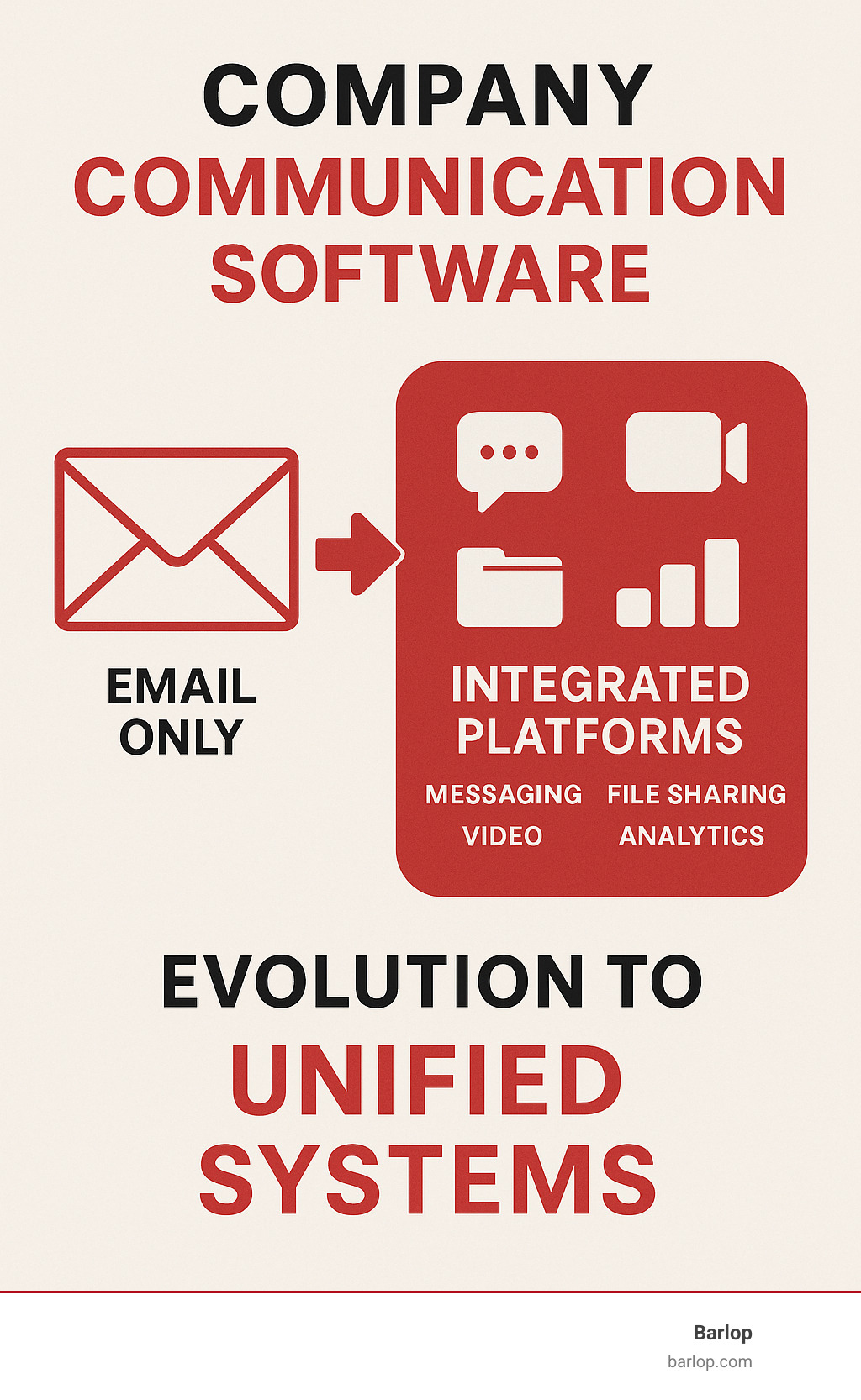Company communication software is a suite of digital tools designed to streamline internal communication, improve collaboration, and connect teams across various locations. These platforms unify messaging, video calls, file sharing, and workflow management, replacing outdated email chains and fragmented methods.
Top communication software categories include:
- Team chat platforms for daily collaboration
- Video conferencing tools for virtual meetings
- Unified communications for all-in-one phone, video, and messaging
- CRM-integrated tools for customer-facing teams
The shift to modern communication software isn’t just about keeping up with trends. It’s about survival in today’s work environment.
Teams using integrated communication platforms see a 47% increase in productivity and 35% time savings through automation. Even more telling, 90% of users report feeling more connected to their colleagues when using modern communication tools.
The old way of working, scattered across emails and basic messaging apps, creates information silos that slow decision-making. Important updates get buried, remote workers feel disconnected, and projects stall while teams hunt for files across multiple platforms.
Modern company communication software fixes these problems by creating a single hub where work happens. Whether your team is in Miami, working remotely, or split between office and field locations, the right platform keeps everyone aligned and productive.
For businesses with 10-150 employees, this technology shift is particularly important. You’re large enough to feel the pain of poor communication but small enough that every productivity gain matters to your bottom line.

The Core Benefits of Centralized Communication
Imagine a world where finding a crucial document doesn’t involve sifting through hundreds of emails. That’s the magic of centralized communication. By bringing all interactions into one platform, modern software offers benefits that directly impact your business’s efficiency and morale.
One of the most significant advantages is the streamlining of workflows. Instead of toggling between multiple apps, everything is in one place. This reduces the mental load on team members and allows them to focus on their actual tasks, not on managing communication tools. This seamless integration means fewer delays and a smoother flow from idea to execution.
Furthermore, these platforms dismantle information silos. In traditional setups, different departments might operate in their own communication bubbles, leading to missed opportunities. A centralized system ensures that relevant information is accessible to all who need it, fostering transparency and breaking down barriers between teams. This leads to faster decision-making, as all necessary context is readily available.
Beyond efficiency, company communication software dramatically increases employee engagement. When team members feel connected, heard, and informed, their morale improves. The ability to easily collaborate and share successes contributes to a positive work environment. As noted earlier, teams using these platforms see a 47% increase in productivity, and 90% of users report feeling more connected. This isn’t just about getting work done; it’s about building a happier, more cohesive team. According to Gallup’s research on workplace engagement, engaged employees show significantly higher performance and retention rates.
Adapting to the Future of Work
The way we work has changed, and our communication tools must change with it. The rise of remote and hybrid work means our teams are no longer confined to a single office. Our colleagues might be working from home in Miami, a coffee shop in Fort Lauderdale, or a different time zone. Company communication software is designed to support these distributed teams, ensuring everyone stays in sync.
A key aspect of this adaptation is supporting asynchronous communication. Not all conversations need to happen in real-time. For teams spread across different time zones, the ability to leave messages and share updates without needing an immediate response is invaluable. This reduces the pressure of constant availability and allows for more thoughtful responses.
Maintaining company culture remotely is another challenge that modern communication tools address. When people aren’t bumping into each other in the hallway, it’s easy for the sense of community to fade. These platforms provide virtual spaces for informal interactions and team bonding, creating a digital water cooler effect. Features like social feeds and dedicated channels for non-work topics help foster a sense of belonging. Research shows that employees who feel they belong are 5.3 times more likely to feel empowered to perform their best work. This empowerment is vital for productivity and innovation. To learn more, you can explore resources on how to improve team communication with the right software.
Key Features to Look for in Company Communication Software
Shopping for company communication software can feel overwhelming. There are many options, each promising to revolutionize how your team works. But what matters most are the features that actually make your daily life easier.

The must-have features for any solid platform start with real-time messaging, reliable video conferencing, and simple file sharing. The magic happens when these tools integrate seamlessly with the apps you’re already using.
Security protocols are absolutely critical for protecting your business. Think of them as the digital equivalent of locking your office doors at night. For a comprehensive breakdown of what makes these platforms tick, check out our guide on Features to Look for in Company Communication Software.
Core Collaboration and Communication Features
The heart of any great communication software lies in how well it handles the basics. These are the features your team will use daily, so they must work smoothly.
Instant messaging channels act as digital office spaces. You can create dedicated channels for projects, topics, or teams to keep discussions organized. This includes group chats for projects and 1-on-1 messaging for quick, direct conversations.
Video and audio calls have become essential. High-quality video allows you to see facial expressions during important discussions, while screen sharing turns any conversation into a collaborative workspace where you can show exactly what you mean.
Mobile accessibility is no longer just a nice-to-have; it’s essential. Your field workers, traveling sales team, and anyone away from their desk needs full access to conversations and files. The best platforms work just as well on a phone as on a desktop.
Searchable history is like having a perfect memory for your entire team. If you need to find an idea someone mentioned weeks ago, you can simply search for it. This feature saves countless hours and prevents good ideas from disappearing.
Productivity and Workflow Integration
Here’s where communication software transforms from a simple chat app into a productivity powerhouse. The best platforms don’t just help you talk; they help you get things done.
Task management integration means you can turn any conversation into actionable work. When someone mentions a great idea, you can create a task right there, assign it, and set a deadline.
Workflow automation is where things get exciting. Imagine automatically sending project updates, generating reports, or routing approval requests. Teams report saving 35% of their time through automation, which translates to real hours they can spend on meaningful work.
The average team uses dozens of apps integrated within their communication platform. Your project management tool can talk to your calendar, which connects to your file storage and customer database. Everything flows together seamlessly.
Calendar syncing ensures everyone knows when meetings are happening. Status updates let team members communicate their availability without constant interruptions, acting as a digital “Do Not Disturb” sign.
Administration and Security Essentials
Administrative features are what separate professional-grade software from consumer apps. Think of these as the foundation that everything else builds on.
User management gives you control over who sees what. You can easily add new team members, remove those who leave, and set granular permissions so sensitive information stays with the right people.
Data encryption protects your conversations and files from prying eyes. Everything is scrambled during transmission and storage. Compliance standards like GDPR and HIPAA aren’t just legal requirements; they’re proof that the platform takes security seriously.
Implementing clear messaging policies helps maintain professional standards while giving teams the flexibility to communicate naturally. It’s about finding the right balance between security and usability.
Reliability might be the most important feature of all. A system that crashes during a big client presentation is worse than no system at all. Look for platforms offering 99.999% uptime guarantees, which is less than five minutes of downtime per year.
Data loss prevention features act as a safety net, preventing sensitive information from accidentally leaving your secure environment. These tools catch potential problems before they become real headaches.
A Guide to the Main Types of Company Communication Software
The world of company communication software can feel overwhelming. With countless options available, where do you begin? The secret is understanding that different tools are designed to solve different problems.
What works for a creative agency might be wrong for a manufacturing company. A solution that energizes a small startup could overwhelm a traditional business. That’s why we need to look at the main categories of communication tools and understand what each one does best.

Think of this as your roadmap through the software landscape. By matching your specific business needs to the right type of tool, you’ll invest in a solution that improves your operations instead of adding complexity. For more detailed guidance, check out our resource on choosing the best communication tools for your business.
Collaboration Hubs & Team Chat Platforms
Collaboration hubs and team chat platforms create a virtual office where every conversation, file, and project update lives in one organized space. These digital workspaces are the heartbeat of modern team communication.
These platforms feature persistent chat channels organized by topic, project, or department. Unlike emails, these conversations are easily searchable, ensuring no information is lost. The magic happens through extensive integrations with other business tools, allowing your project management app, document storage, and calendar to feed information directly into your chat channels.
File sharing becomes effortless, and you can start a quick video call right from the chat when typing isn’t enough. Tech companies, startups, and project-based teams find these tools particularly valuable for rapid iteration and cross-functional projects.
Video-First Conferencing Solutions
Sometimes you need to look someone in the eye, even when they’re miles away. Video-first conferencing solutions make virtual face-to-face interactions feel natural and productive.
These platforms prioritize crystal-clear video and audio quality. Beyond basic calls, they offer features like breakout rooms for small group discussions, virtual backgrounds, and recording capabilities. Advanced features like live transcription and translated captions improve accessibility, while interactive tools like polls and whiteboards turn passive meetings into engaging experiences.
Sales teams rely on these tools for client presentations, educational organizations use them for virtual classrooms, and large enterprises depend on them for company-wide communications. Modern platforms can even embed a speaker directly into their slides, making remote presentations more engaging.
All-in-One Unified Communications (UCaaS)
For businesses tired of juggling separate systems for phones, video, and messaging, unified communications platforms offer a breath of fresh air. These solutions replace traditional phone systems while adding modern communication features under one roof.
At their core, these platforms provide robust Voice over Internet Protocol (VoIP) phone systems with business numbers, call routing, and voicemail-to-text transcription. The same platform handles video conferences, team messaging, and often includes contact center features for customer service teams.
This consolidation reduces costs by eliminating multiple service providers and simplifies IT management. When your entire communication infrastructure runs through one platform, reliability is critical. The best providers guarantee 99.999% uptime because they understand that communication downtime means business downtime.
CRM-Integrated Communication Tools
When every conversation impacts customer relationships, generic tools fall short. CRM-integrated communication tools bridge this gap by combining customer data with communication features.
These platforms connect deeply with customer relationship management systems, giving your team complete context before every interaction. Imagine answering a customer call and instantly seeing their purchase history and previous support tickets. That’s the power of integrated communication.
Email integration enables automated campaigns and personalized outreach. Live chat features provide real-time customer support directly on your website, with all conversation history maintained within customer records. Sales, marketing, and support teams use these tools to create seamless customer experiences, ensuring every team member has the information they need to provide exceptional service.
How to Choose the Right Communication Software for Your Business
Selecting the ideal company communication software is a crucial decision that impacts your team’s productivity, collaboration, and bottom line. It’s not about picking the most popular tool, but the one that best fits your specific operational rhythm and strategic goals.

Our process involves a thorough needs assessment, careful budget considerations, and a forward-looking view on scalability. We also pay close attention to user feedback and any industry-specific requirements that might influence our choice.
Assessing Your Team’s Unique Needs
Before diving into features and pricing, we must first deeply understand our team’s unique needs. This isn’t a one-size-fits-all world, and our communication solution shouldn’t be either.
First, consider our company size. A smaller team might thrive on a minimalist platform, while a larger organization will require robust administrative controls. Next, we analyze our work environment: are we primarily in-office, a hybrid team, or fully remote? Each setup presents distinct communication challenges. Remote collaboration software, for instance, focuses on bridging geographical gaps for hybrid teams.
A critical distinction is between frontline and desk workers. Our frontline employees, perhaps working in Fort Lauderdale or Miami Dade, often rely on mobile devices and need quick access to information. Their needs might prioritize instant alerts and easy-to-use messaging. Desk workers might need more extensive integration with project management tools and advanced video conferencing.
Finally, we consider the technical skill level of our users. A platform with a steep learning curve can lead to low adoption and frustration. We prioritize user-friendly interfaces to ensure our team can quickly integrate the new software into their daily routines.
Evaluating Security, Compliance, and Budget
Beyond features and usability, the practicalities of security, compliance, and budget are paramount. These elements ensure the longevity and integrity of our communication infrastructure.
First, let’s talk about the total cost of ownership. This isn’t just the sticker price. We need to factor in per-user pricing, potential add-ons, and implementation costs. While some platforms offer free tiers, these often come with limitations. Paid tiers vary widely, so a thorough cost-benefit analysis is essential. We should budget for about 10-20% over the base price for unforeseen needs.
Security and compliance are non-negotiable. We must ensure the chosen software employs robust data encryption, supports single sign-on (SSO), and provides role-based access to protect sensitive information. Features like data loss prevention are crucial for safeguarding proprietary data. We also verify that the platform complies with relevant industry standards and regulations. When considering uptime, we look for service level agreements (SLAs) that guarantee high availability, like the 99.999% uptime offered by leading providers.
Finally, we consider data residency requirements. Depending on our industry or customers, there might be regulations dictating where our data must be stored. We ensure that our chosen provider can meet these geographic data storage needs, adding another layer of compliance.
The Next Wave: How AI is Changing Business Communication
The world of company communication software is experiencing a revolution, and artificial intelligence is leading the charge. What once seemed like science fiction is now part of our daily work reality, changing how we connect and collaborate.
Think about those endless meeting notes you used to scribble down. AI-powered summaries now handle that, automatically generating clear, actionable notes that highlight key decisions and next steps. No more frantically typing while someone’s sharing crucial information.
The magic extends to how we find information. Intelligent search has evolved beyond simple keyword matching. These smart systems understand context, so when you’re looking for “that conversation about the Miami project budget,” the AI knows what you mean, even if those exact words weren’t used.
AI-powered chatbots are becoming the heroes of internal operations, fielding routine IT and HR questions around the clock. Need to reset your password at 9 PM or check your vacation balance on a Sunday? The AI assistant has you covered. This frees up human colleagues to focus on complex, creative work.
Perhaps most intriguingly, predictive analytics are giving us new insights. By analyzing communication patterns, AI can spot trends that might indicate team stress or communication bottlenecks. It’s like having a crystal ball for workplace dynamics. To explore more about where this technology is heading, check out the future of workplace communication trends and technologies.
The Practical Impact of AI on Daily Work
The real test of any technology is how it improves our day-to-day work. The numbers tell a compelling story: people using AI-improved communication tools are saving an average of 97 minutes per week. That’s nearly two hours returned to your schedule every single week.
One of the most practical applications is automated task creation. Imagine discussing a new marketing campaign in a team chat, and someone mentions they need to “update the website copy by Friday.” The AI can catch this, automatically create a task, assign it, and set the deadline. No manual follow-up needed.
Real-time language translation is breaking down barriers. Whether you’re collaborating with international partners or supporting a diverse local team, language differences no longer slow down progress. The AI translates conversations on the fly, making everyone feel included.
Sentiment analysis adds another layer of workplace intelligence. The AI can detect when team communications show signs of stress or frustration. This early warning system helps managers address issues before they become bigger problems.
For customer-facing teams, AI agents are revolutionizing support. Advanced systems can handle complex customer queries, integrate with existing help desk software, and escalate to human agents only when necessary. This proactive issue resolution means faster responses for customers and less routine work for support teams.
Conclusion: Unifying Your Team for Success
As we wrap up, it’s clear that company communication software is more than just a chat app. It’s the digital backbone that keeps modern businesses thriving, whether your team is scattered across Miami-Dade, working from home, or collaborating from different time zones.
We’ve explored how the right platform can transform your workplace, leading to a 47% productivity boost and 35% time savings through automation. These numbers mean more time for meaningful work, faster decisions, and stronger connections between colleagues, regardless of location.
The features we explored—from instant messaging and video calls to robust security and app integrations—work together to create a unified workspace. They eliminate frustrating information silos and ensure remote team members feel included.
Understanding the different types of solutions gives you the power to make an informed choice. Whether you need a collaboration hub, a video-first platform, an all-in-one system, or CRM-integrated tools, there’s a solution designed for your specific challenges.
The selection process is just as important as the features. Assessing your team’s needs, considering your budget, and prioritizing security are essential for long-term success. With AI now offering everything from automated meeting summaries to real-time translation, the future holds even more exciting possibilities.
Communication is the cornerstone of success. The right company communication software doesn’t just connect your team—it amplifies their potential, streamlines their efforts, and creates an environment where great work happens.
At Barlop, we understand that every business has its own communication rhythm. We’re committed to helping you find the perfect solution that not only meets your current needs but grows with you.
Ready to transform how your team communicates and collaborates? Explore our unified communication solutions and find how we can help unify your team for success.




